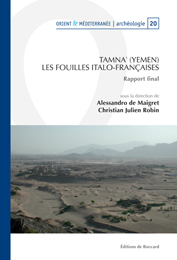Tamnaʿ (Yemen). Les fouilles italo-françaises
Rapport final

sous la direction d’Alessandro de Maigret et Christian Julien Robin
Tamnaʿ est une ville du Yémen antique qui fut la capitale du royaume sudarabique de Qatabān. Ses vestiges, aujourd’hui appelés Hajar Kuh. lān, se trouvent au débouché d’une vaste vallée, le wādı̄ Bayh. ān, en bordure du désert intérieur du Yémen. Les premières fouilles furent entreprises par une mission américaine en 1950 et 1951, alors que Bayh. ān était un protectorat britannique sous la direction des sharı̄f de Bayh. ān. Elles furent reprises en 1999, alors que le Yémen était réunifié depuis près de 10 ans, par une mission italo-française dirigée par les professeurs Alessandro de Maigret et Christian Robin. Trois chantiers principaux ont été ouverts : un au nord et un au centre de la ville, un troisième dans la nécropole voisine de H. ayd ibn ʿAqı̄l. Les résultats sont importants puisque Tamnaʿ est la première ville antique du Yémen où une fouille extensive a été entreprise. Ils se rapportent à la vie religieuse, à l’organisation d’une capitale antique dont les ressources étaient tirées principalement de l’agriculture et du commerce, à l’architecture religieuse et domestique et aux rites funéraires. Mais l’apport le plus notable concerne la chronologie, puisqu’une stratigraphie complète a été élaborée par le professeur de Maigret. Celle de la période finale a pu être améliorée considérablement, jusqu’à l’abandon de la ville à la suite d’une destruction violente, peu avant le milieu du IIe siècle de l’ère chrétienne. Pour les périodes plus hautes, une chronologie relative commence à se dessiner, mais sans ancrage assuré dans la chronologie absolue.
Tamnaʿ, one of Yemen’s ancient cities, was the capital of the South Arabian kingdom of Qatabān. Its ruins, which are now called Hajar Kuh.lān, are located in a broad valley, the wādı̄ Bayh.ān, bordering the inner desert of Yemen. The first archaeological investigations were carried out by an American Mission in 1950 and 1951, when the region was a British protectorate under the leadership of the sharı̄fs of Bayh.ān. The excavations and researches were launched in 1999 – nearly 10 years after the unification of Yemen – by the Italian-French mission directed by Pr. Alessandro de Maigret and Pr. Christian Robin. The excavations were carried out in three main sectors: the first to the north of the city, the second to the centre, and last in nearby cemetery of H.ayd ibn ʿAqı̄l. The results are considerable since Tamnaʿ is the first ancient city of Yemen where an extensive excavation was carried out; they relate to the religious life, the organization of an ancient city whose resources were drawn mainly from agriculture and trade, and also to the religious and domestic architecture and to the funeral rites. But the most important contribution relates to the chronology, since a complete stratigraphy has been developed by Pr. de Maigret. The chronology of the final period of Tamnaʿ was considerably improved, up to the abandonment of the city following its violent destruction, shortly before the middle of the 2nd century AD. As the earlier periods, a relative chronology starts to emerge, but without a sure anchoring in the absolute chronology.




